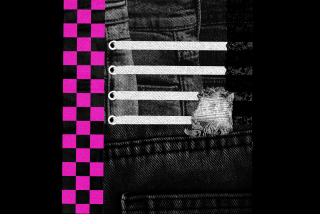Review: The past is not only prologue in ‘The Topeka School,’ it’s happening now.
- Share via
In his third novel, “The Topeka School,” Ben Lerner continues to mine his reality much like his debut, “Leaving the Atocha Station” and the luminous followup, “10:04.”
This time, Lerner summons more sociopolitical heft by casting back to late ’90s Kansas, his formative years. Taking “the past is prologue” approach, “The Topeka School” is one white male’s attempt to consider how white men, as the dominant power in this country, brought us to this current moment of “toxic masculinity,” the catchall explanation for male violence and misogyny.
This hot-button topic is examined with authentic intellectual interrogation. “The Topeka School” delves into the male aspect much more than race, which some may read as a failure to acknowledge an intersectional identity. But it hones the novel’s focus.
Lerner, with his poet’s eye for the strengths and fallibility of language, is precise and prismatic in his investigations. He repeatedly returns to certain phrases and ideas (“America is adolescence without end” being particularly important). And each time, he invests the phrase or idea with new meaning, accumulated from all that has occurred in the novel since the last mention.
The psychoanalytic idea of processing is another repeating motif that plays out a little differently for every character in “The Topeka School.” Lerner’s alter ego, Adam Gordon (the same one who anchored his debut), returns as a teenager in 1997 Topeka. Gordon is gifted in debate (he’s expected to win the national championship in extemporaneous speaking— something Lerner himself accomplished), poetry and freestyle rap.
With a teenager’s insecurity, Gordon pumps iron and monitors his own behavior for breaks in the masculine code, like appearing too interested in his girlfriend’s family (one of the few characters, curiously, who isn’t fleshed out). He narrates the book, along with a future Gordon (married in Brooklyn with two young daughters), and Gordon’s parents, both therapists at Topeka’s prominent psychiatric clinic, navigating the twists of their shambolic marriage and fits of temper from their adolescent son.
The chapters narrated by Gordon’s mother, Jane, a famous feminist author, much like Lerner’s real mother, are a revelation. She receives harassing phone calls from “the men,” the kind who would eventually troll the internet, angry at her theories. And she trolls them back by asking them to repeat themselves, as if she can’t hear.
Inevitably they lose steam and hang up. “I couldn’t really take them seriously,” Jane Gordon says, “or only took them seriously as specimens of the ugly fragility of masculinity. She’s not a victim; she’s an empowered observer using her experience to gain more wisdom. Her processing of the threats frame both the absurdity and the potential danger, calling to mind the famous Margaret Atwood quote (“Men are afraid women will laugh at them; women are afraid men will kill them”).
The novel possesses a nominal plot, more symbolic than anything (sometimes preciously so): One of Gordon’s contemporaries, an intellectually debilitated teenager named Darren, is welcomed into Topeka High School’s bro culture as a pet or mascot. Eventually, Darren commits a grave act of violence, egged on by his so-called friends. (There are also the occasional syntax-scrambled passages in italics that occupy Darren’s close third person point of view.) The diffuse quality of the book’s events can be frustrating at the start, when Lerner is laying out his touchstones that haven’t yet paid off. But once they accrue their power, the specificity of setting and character all coalesce to make an uncanny and gripping read.
A key analog to “The Topeka School,” one that Lerner subtly name-checks in the text, is Thomas Frank’s 2004 book, “What’s the Matter with Kansas?” The book tracks how the state flipped from blue-collar Democrat to populist Republican in the ’90s, namely with the election of Sen. Sam Brownback (who eventually became governor in 2011).
One of the most sharply drawn characters in “The Topeka School” is Gordon’s debate coach, Peter Evanson. Pumping up Gordon to win the next debate, Evanson delivers the novel’s most cynical but politically potent idea about the manipulative powers of language:
“What you have in your favor is Kansas… I want quick swerves into the folksy. ‘You can put lipstick on a pig, but it’s still a pig.’ That kind of thing. I want you saying, right after some hypereloquent riff about Yeltsin breaking a promise, `Now, in Kansas, we call that a lie’… I don’t care if they’re not real sayings, just deliver them like they’re tried-and-true.”
Gordon goes on to tell how Evanson became “a key architect of the most right-wing governorship Kansas has ever known … an important model for the Trump administration.”
The past is not only prologue in “The Topeka School,” it’s happening now. What, “The Topeka School” implicitly asks, will happen in the future?
Ben Lerner
Farrar, Straus and Giroux: 304 pages, $27
Wappler is the author of “Neon Green” and a former cohost of the Pop Rocket podcast.
More to Read
Sign up for our Book Club newsletter
Get the latest news, events and more from the Los Angeles Times Book Club, and help us get L.A. reading and talking.
You may occasionally receive promotional content from the Los Angeles Times.






